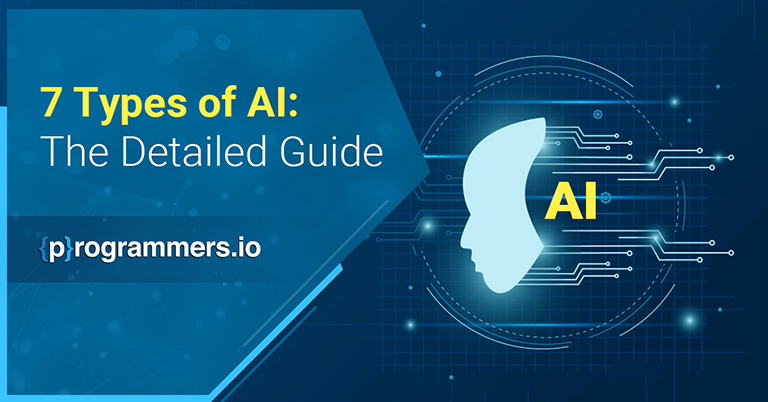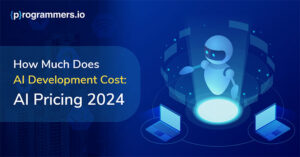Artificial intelligence (AI) is transforming many industries today; it is accomplishing this by making processes better, automating work, and providing accurate predictions about what might happen next. But there is more than just one type of AI. Each type has unique functions and capabilities that allow it to perform specific tasks. Here is a detailed review of the seven types of AI.
History of AI
The name “artificial intelligence” was coined by John McCarthy in 1956. At first, AI research tried to make machines do things usually done by humans, like playing chess and solving math problems. Over time, increasing computational power and more data have made AI development services much faster. This has led to the advanced AI applications we see today.
The Advent of AI (1950s-60s)
The term “artificial intelligence” was suggested in the middle of 1950s by John McCarthy at the Dartmouth Conference. Many people believe this event is where AI officially began as a field of research. At the start, research on AI had very ambitious aims. The goal was to create systems that could perform tasks which normally need human involvement and smart thinking.
At this time, researchers mainly work on symbolic AI, which people often call “good old-fashioned AI” (GOFAI). This kind of AI concentrates on managing symbols and applying formal logic. Early accomplishments were truly amazing with software able to solve math equations and participate in games like chess.
The First AI Winter (1970s-1980s)
AI research began in the 1950s with many people excited and a lot of money being put into it. But during the 1970s and 1980s, interest slowed down. This time was often called “AI winters.” During these times, money and interest for AI became less because the first AI systems did not live up to what people thought they could do.
In these years, symbolic AI had problems with growing bigger and being adaptable. Because of this, scientists began searching for different ways to solve things. A new way was by creating expert systems that used knowledge from people who are experts in certain areas. Although these expert systems had some success in business, they faced limits since they could not use new information and adapt to changes.
The Rise of Machine Learning (1990s-2010s)
AI began to rise again in the 1990s with the arrival of machine learning. This was a major shift from using systems that followed fixed rules to adopting new methods where algorithms learn from data. During this period, important advancements in computational power happened, and bigger amounts of data became available. These were vitalfor training machine learning models.
Methods like neural networks, which people did not use much during the first AI winter, came back with big improvements. This brought new progress in deep learning. Some big achievements during this time are IBM’s Deep Blue beating world chess champion Garry Kasparov in 1997 and the development of speech-recognition systems.
The Era of Big Data and Deep Learning (2010s-Present)
During the 2010s, AI progress became very fast with new types of AI that could handle big data, had stronger computational abilities, and used better algorithms. Deep learning brought a major shift in this area by letting highly advanced models do complex tasks such as identifying images and voices, understanding human speech, and even driving cars without human help.
Companies like Google, Facebook, and Amazon began spending a lot of money on AI research. This accelerated progress and helped make using AI more normal. Important things happened during this time, such as Google’s AlphaGo beating Lee Sedol, who was the top Go player in 2016, and development of strong AI programming languages like OpenAI’s GPT series is important development too.
Evolution of AI
AI has evolved through several significant milestones:
- 1956: John McCarthy coins the term artificial intelligence.
- 1969: DARPA funds AI research projects.
- 1974-1980: Entry of expert systems capable of decision-making.
- 1997: IBM’s Deep Blue victory over grandmaster Garry Kasparov.
- 2011: IBM’s Watson winning popular quiz show Jeopardy.
- 2019: AlphaZero victory over world champion in Go.
- 2022: Release of ChatGPT.
Understanding Artificial Intelligence: How Intelligent Machines are Transforming Our World
Companies in the healthcare, finance, and transportation industries are fast becoming reliant on AI technologies. It is because these technologies can think like humans to manage data and make decisions on their own. This changes how companies operate and allows them to understand data more effectively, automate tasks, and reduce costs.
Types of AI
Artificial intelligence can be grouped by its abilities and purposes. This grouping aids in grasping where AI technology stands now and what it could achieve later on. Here are the types of AI separated into capability-based and functionality-based artificial intelligence.
Capability-Based Types of Artificial Intelligence
Narrow AI (Weak AI)
Narrow AI, also called Weak AI, can perform specific tasks. It works well in a restricted range and does not go beyond its set capabilities. Some examples of this AI around us are Alexa and Siri, IBM’s Watson, and self-driving cars.
Artificial General Intelligence (AGI)
AGI or Artificial General Intelligence can like think, learn, and make decisions like humans. Right now, AGI is mostly an idea because no current system can do all these things completely.
Artificial Superintelligence
Artificial Superintelligence (ASI) is a type of AI that goes beyond human intelligence, doing any task better than humans can. This kind of AI is still just an idea and shows the highest point in developing AI. It includes machines that know themselves and are able to exceed human thinking skills.
Functionality-Based Types of Artificial Intelligence
Reactive Machine AI
Reactive machines are simplest kind of AI. They made to answer certain stimuli without using memory or past happenings. One example is IBM’s Deep Blue, a computer that play chess only by looking at position right now and making choices based on it each move in present time.
Limited Memory AI
Limited memory AI can make sound decisions using the historical data available to it. Applications of this can be seen today in self-driving cars and chatbots, which inform future actions by using historical data.
Theory of Mind AI
Theory of Mind AI is a forward-thinking idea that concentrates on grasping human feelings and actions. It’s still being developed but the goals remains the same—interact with humans like one of them by identifying and appropriately reacting to their emotional signals.
Self-Aware AI
There is no higher level of AI than self-aware AI—it can understand itself and have consciousness just like humans. This type of AI is still a concept and seen as the final aim in studying AI technology.
Examples of Types of AI
Narrow AI
Some examples of narrow AI are virtual assistants like Siri and Alexa. These helpers use natural language processing so they can understand what users talk and then respond to their needs or questions. Another example is IBM Watson. It can look at a big amount of data to help doctors make choices about health problems.
Artificial General Intelligence (AGI)
Different from narrow AI, AGI can do any smart task that a human does. It has the power to use knowledge and skills in many different areas. Right now, AGI is just an idea; it is not real yet. But in science fiction stories, you often see advanced robots or systems with intelligence like humans that think and understand things similar to people.
Artificial Superintelligence
Such an AI might perform better than humans in nearly all fields and could bring huge changes to our society. Even though this sort of AI does not exist yet and remains a concept from imagination, it makes us ponder over serious ethical and existential issues about how we can manage these highly intelligent systems safely, along with what impacts they may have on human lives.
Reactive Machine AI
IBM’s Deep Blue, the computer known for playing chess and defeating world champion Garry Kasparov in 1997, is a good example of reactive machine AI. Deep Blue could examine many possible moves and their outcomes to decide on the best strategy during the game. But it could not learn or adapt from previous games; it just followed predefined rules and carried out real-time analysis during play.
Limited Memory AI
Examples of this AI in our everyday lives are chatbots, self-driving cars, and virtual assistants. For example, self-driving cars learn from trips they have made in the past to improve their driving and keep passengers safe. On other hand, chatbots learn from old chats to give more correct and helpful replies. Limited memory AI systems can change with new info and improve little by little, but their learning stays focused on only certain jobs and specific data.
Theory of Mind AI
A good example of this kind AI is Kismet, created by MIT. This robot understands and reacts to human emotions using face expressions and voice tones. Although Theory of Mind AI is an important advance for more human-like communications, it still requires much research and effort because current achievements are quite limited.
Self-Aware AI
Something people still dream about self-aware because we do not have the technology and understanding to make a machine truly aware of itself. This idea brings up serious thoughts about ethics and philosophy, making us question what it really means to be conscious. It also makes us wonder what could happen if we ever create machines that think like humans and can take actions by themselves.
What is the Most Common Type of AI Used Today?
Narrow AI is the type of artificial intelligence we see most often nowadays. It operates in many different fields, such as virtual assistants and recommendation systems, also self-driving cars and medical diagnostic tools.
AI at Programmers.io
At Programmers.io, we use many types of AI for developing new solutions. Being an AI software development company, we give AI software development services that improve business tasks, make work faster, and help with growth. We have good understanding of many kinds of AI technologies, so we can develop unique solutions that match what each client wants.
Conclusion
We must understand and keep track of the different types of AI as it advances and becomes more common in our everyday life. One type of AI, Narrow AI, is already making an impact. It is good at doing one or a few jobs at the same time only. General AI (AGI) is something that experts dream to realize sometime in the future. This type can do any smart work that a person is able to do.
Artificial Superintelligence is more advanced than AGI and would be smarter than humans in every way. AI has only just begun, with Narrow AI already making an impact. There are exciting future possibilities like AGI and Artificial Superintelligence that we look forward to seeing. By using these technologies, we can unlock new opportunities and advance innovation in many different areas.




